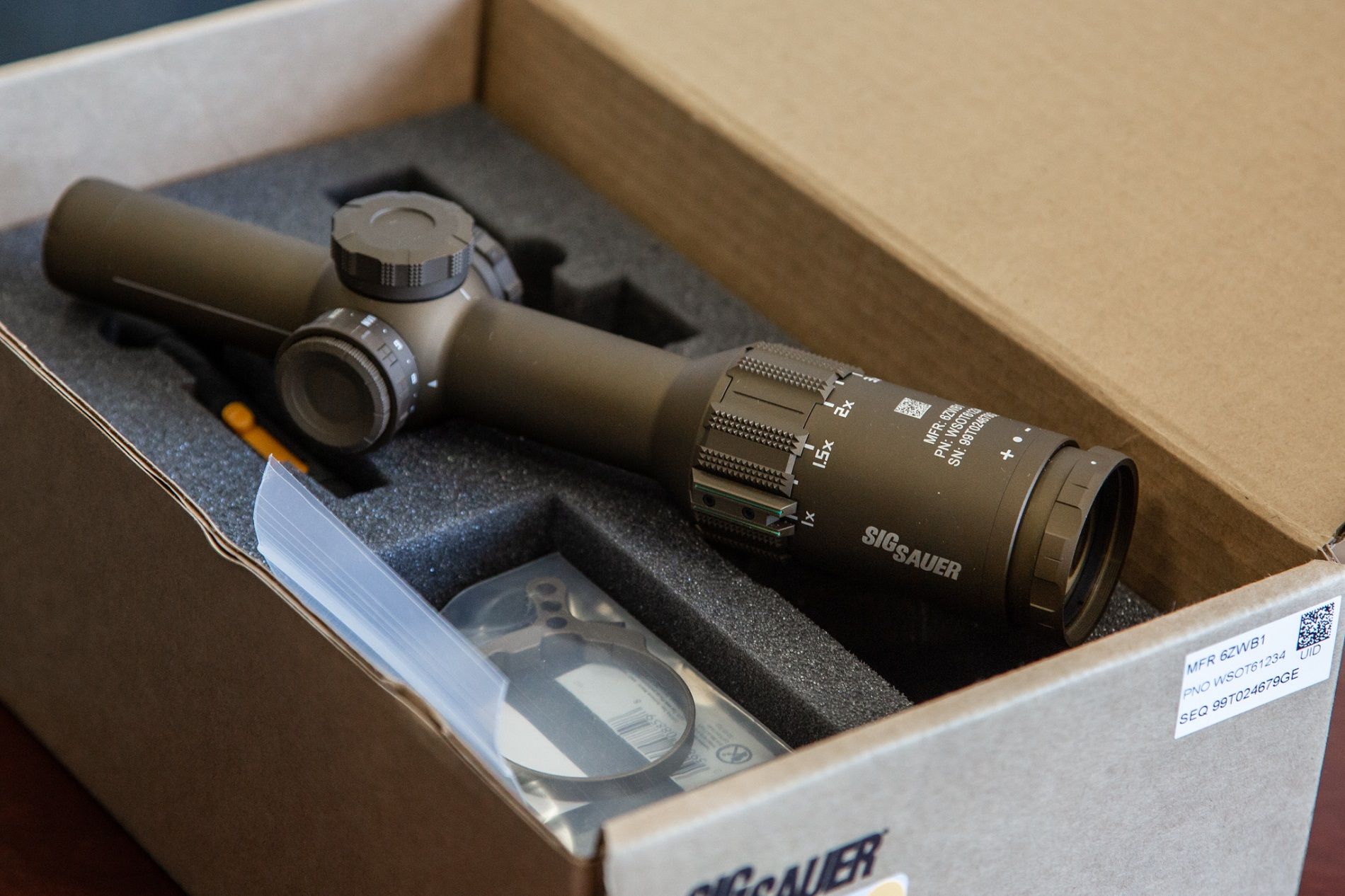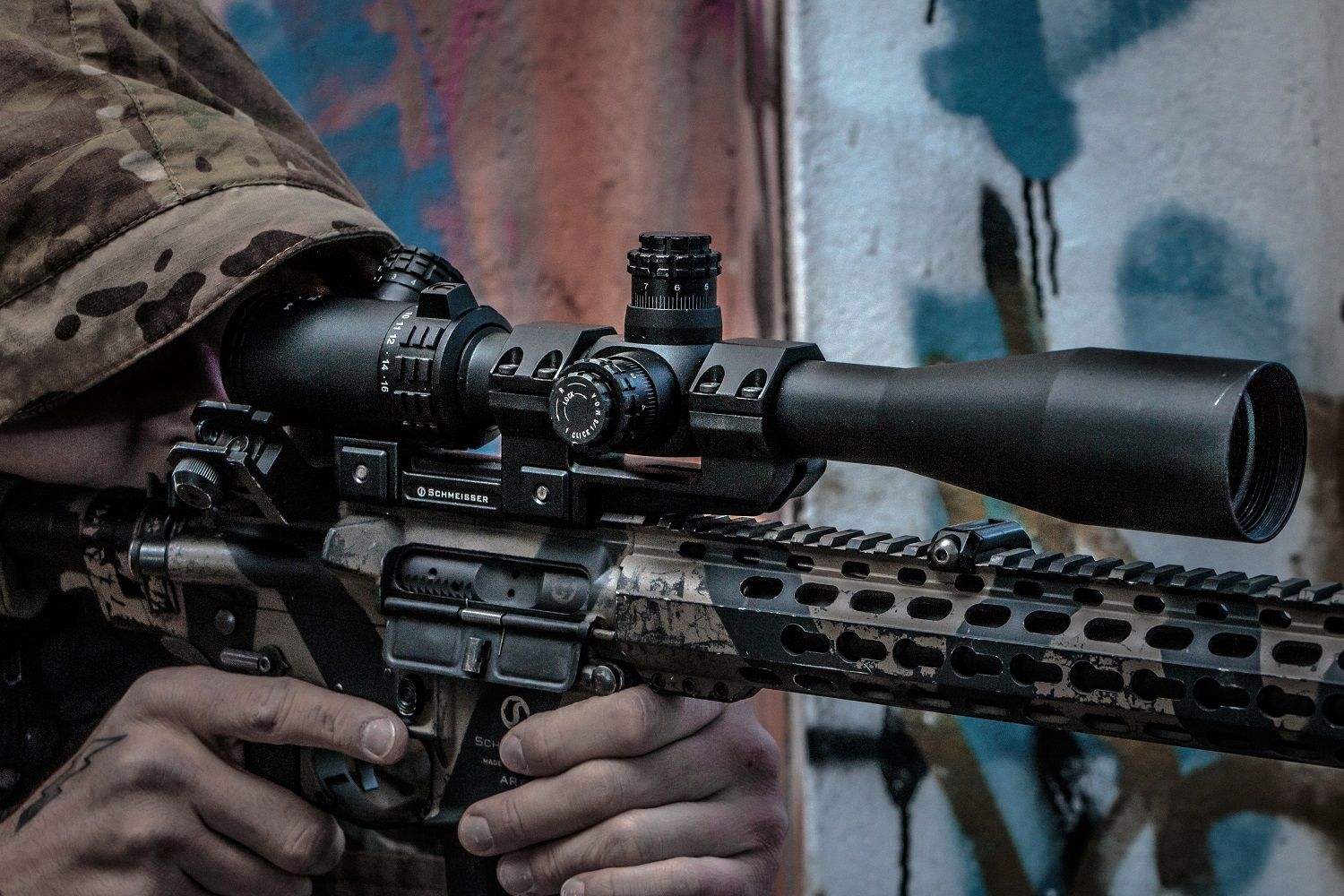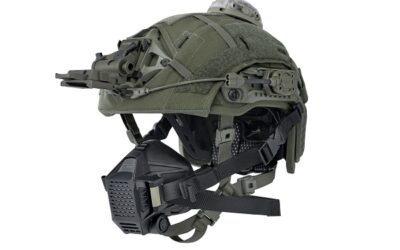Rifle Scopes in the Spotlight
An in-depth overview of reticle designs, from a simple dot at the point of aim to those with a variety of marks and lines intended to help the shooter to estimate the target’s range and to correct for bullet drop under extant gravity, wind and target movement conditions.
Rifle optics must present the shooter with a clear image of the target and an aiming mark. From close quarter battle ranges up to about 100m, with flat-shooting rounds and a weapon zeroed at that distance, those two things have long been all the targeting technology that an infantry soldier had. Longer-range engagements are the preserve of designated marksmen and snipers, who are issued with more sophisticated optics plus, in the latter case, a spotting partner, range and wind measuring equipment, ballistic computers, complicated reticles and protracted, intensive training.
Rifles are capable of consistently hitting targets at great distances with the first shot, but they are held back by environmental effects on the bullet’s flight and by the soldier’s ability to aim accurately under extreme stress. In 2005, the US General Accounting Office (GAO) reported that the US military used about 250,000 rounds for every insurgent killed in Afghanistan and Iraq. While most of those rounds were used in suppressive fire, the need for such fire is in part driven by an inability to hit selected targets at longer ranges. This is on the cusp of radical change as leading militaries sponsor the development of advanced fire control systems for rifles and industry offers solutions of its own, more of which later.
Simple Scopes Go Digital
For more than a century, the rifle scope has been a relatively simple device, consisting of a telescope with a reticle. The telescope can either be of fixed or variable magnification and always includes dioptre focus adjustment to allow for variations in individual shooters’ eyesight. Most also include adjustment for parallax errors, which occur when the target and reticle do not appear in the same plane in the scope. The core technology is mature, although refinements in optical design and the use of improved glass, with a higher refractive index and better transmissivity along with advanced coatings, improve their light-gathering power and reduce distortion and internal reflections to provide the clearest possible image of the target. Illuminated reticles are increasingly offered, while the best quality scopes are also nitrogen purged and O-ring sealed to prevent fogging and feature construction rugged enough to shrug off rough handling in the field and the recoil of heavy calibre rounds. Most can also be used with clip-on image intensified, CMOS or thermal imaging night sights.
Most of the major scope manufacturers with an established presence in the military market, along with a few relative newcomers, offer this kind of technology, including Burris, Bushnell, Hensoldt, Leupold, Nightforce, Schmidt & Bender, SIG Sauer, Steiner and Sightmark. They are also going digital, in that the latest scopes can accept data from external devices such as laser rangefinders via Bluetooth and display it to the shooter alongside the reticle.
There are many different reticle designs, from a simple dot at the point of aim to those with a variety of marks and lines intended to help the shooter to estimate the target’s range and to correct for bullet drop under extant gravity, wind and target movement conditions. Many scopes are calibrated to particular rounds of ammunition with specified propellant charges, bullet weights, ballistic coefficients and muzzle velocities.
The problem is that most of the time in dynamic, confused and very dangerous combat situations, conventional optics simply don’t provide the shooter with enough information to make first-round hits or quick corrections that can easily be assimilated under pressure.
One approach to solving this problem is centred on improved reticle designs, and most scope manufacturers offer several reticles for various applications over different ranges. However, Horus Vision Reticle Technologies specialises in reticle designs intended to enable trained shooters to rapidly engage targets with reduced correction time between shots using any rifle and ammunition combination.

Reticles Rethought
Featuring grids formed of elevation and windage lines, Horus reticles are designed to be used without the need to manipulate the scope’s windage and elevation knobs, apart from initial zeroing, regardless of range. They are also designed to be used with many different ammunition calibres in combination with the company’s ATrag ballistic software.
ATrag needs the range to target, ballistic coefficient and velocity of bullet, weather data including ambient air temperature, barometric pressure, humidity and wind speed and direction, plus the shooter’s elevation above or below the target to calculate a hold point that corresponds to markings in the reticle. The reticles feature rangefinders calibrated in milliradians (mils) and based on the angles that targets of different sizes subtend at different ranges.
Vertical marks or dots are used to correct for crosswinds at speeds 5-30mph and, as with ballistic hold-overs, windage calculations are appropriate to the ammunition in use and are shown on range cards drawn up for the reticle and the round, shown in mils. On “The Refined Mil Reticle” (TreMoR), for example, wind dots eliminate the need to calculate using wind formulas. With the reticle calibrated to the weapon and ammunition, every dot represents wind speed, and every line an angle in mils.
Wind values are estimated using the clock system and are based on the fact that a crosswind of a given speed at a right angle to the bullet’s flight path will deflect the bullet more than a wind of the same speed from other angles. Snipers typically use the clock system for this, with the shooter at the centre of the ‘clock’ allocating full value to winds from broad sectors centred on two, three and four o’clock on the right and eight, nine and ten o’clock on the left. Winds from sectors centred on twelve o’clock and six o’clock are given a value of zero, while the sectors on either side are given half values. For example, a 10mph wind from one o’clock would have a correction applied as though it were 5mph wind from three o’clock. Moving target leads are handled in an analogous manner.
Follow-Up Shots
If the first round misses, proper use of the grid lines in the reticle can greatly increase the probability of a hit with the second shot, without the shooter having to take their eye off the target or make any adjustments to the scope’s settings. They must remember a few key elements of the first shot, Horus says, namely the elevation marker line used, the point of aim on the target and the exact point of impact. To make the follow-up shot, the shooter repeats the original hold on the target, notes where the impact point appears in the grid, which becomes the new aiming marker. Noting impact points in the grid and using them as the new zero also allows shooters to switch ammunition types in the middle of a firefight if necessary.
The company says that the system takes one or two days to learn, compared with months for conventional mil-dot reticles, and that it is possible to train a platoon for less than it costs to train two snipers using mil-dot scopes. Horus adds that the system also enables ordinary soldiers to serve as back-up designated marksmen or even snipers.
Horus reticles are available in a wide range of scopes from leading manufacturers, and represent a radical rethink of aimed rifle fire in combat using conventional scopes.
Towards Full Fire Control
The next logical step is to replace the conventional scope with a full-up fire control system, which is the direction of travel observable in US military programmes that could result in new optics for sniper rifles and the Next Generation Squad Weapon (NGSW), envisaged as a replacement for the M4 carbine and the M249 Squad Automatic Weapon (SAW).
The Ballistically Optimized Sniper Scope (BOSS), for example, features a 6-22 power direct view optical scope with an integral laser rangefinder, a suite of environmental sensors and a set of inclinometers to measure elevation and cant. The sensors all provide information to an integral ballistic computer that uses the data in combination with rifle and ammunition data to compute the impact point and provide a corrected point of aim. BOSS could be available to US soldiers some time next year.
The Small Arms Weapon and Fire Control (SAWFC) device combines a laser range finder, long-wave infra-red camera and video camera with automatic target tracking software, ballistic and environmental data.
The Rifle Integrated Optics (RIO) system has been described as a head-up display integrated into a scope that enhances the shooter’s view, increases hit probability, improves target recognition and reduces engagement time.
The Advanced Small Arms Ballistic System (ASABS) is intended to be a ballistic computer that uses data from a GPS receiver, laser range finder, compass and environmental sensors, combined with ammunition ballistic data, to improve the shooter’s firing solution in a rifle-friendly package.
Trackingpoint Small Arms Guidance
However, the US military is behind the curve with these technologies. Trackingpoint, for example, has offered its precision guided firearms system for several years on the civilian market and has worked with firearms manufacturers to develop both AR pattern semi-automatics and bolt-action weapons in popular military and commercial calibres, all with the fire control system optics and guided trigger integrated.
The fire control system consists of six subsystems, namely a Target Tracking Optic (TTO), a guided trigger mechanism, a weather station, a Barrel Reference System (BRS), a laser rangefinder and a networking module.
The TTO uses computer vision and artificial intelligence to acquire and track targets selected by the shooter, processing input from more than a dozen sensors along with ballistic data to maintain the shooter-designated point of impact regardless of target or rifle movement. It also controls the trigger.
The guided trigger is linked electro-mechanically to the TTO. As the shooter squeezes the trigger to the half-way point, the TTO stabilises the scene to enable the shooter to ‘paint’ the target with the desired point of impact, which is marked on the target image as a red dot. The shooter then completes the trigger pull and sweeps the crosshair across the red dot: the TTO releases the shot at the right moment to ensure a hit.
The BRS uses a laser to measure and check the weapon’s zero for every shot.
The separate laser rangefinder measures the range to the target when the shooter performs the first part of the trigger pull, and at the same time the thermometer, a barometer and relative humidity sensor in the weather station take readings and correct the firing solution based on the ballistics of the weapon and ammunition combination.
The embedded secure wireless networking system can share the shooter’s view of the target with higher command and provide supplementary target imagery to the shooter in real time though a picture-in-picture facility.
Trackingpoint has offered the US military three rifles: the 5.56mm M600 service rifle, the 7.72mm M800 DMR and the M1400 ‘extreme marksman’ rifle chambered for .338 Lapua Magnum, to replace current squad weapons. The company claims effective ranges of 515, 670 and 1,200yd respectively, defined as the ranges at which 90% of shots are lethal under battle conditions. This compares with 55 and 115yd respectively for the current M4 carbine and M110 DMR.
Smart Shooter Débuts SMASH
Last June, Israeli company Smart Shooter launched a comparable product on the international market. Known as SMASH, it is described as a see-through fire control system that uses image processing for target recognition and tracking. The electro-optics (cameras and laser) are in a square-section housing that fits on the rifle’s accessory rail, with imagery projected into the see-through reflex sight on top. Like the Trackingpoint system, SMASH also controls the trigger.
The user points the weapon at the target area and the image processing detects targets and outlines them for the shooter to select, which he or she does with the press of a button on the rifle’s fore-end. The system then surrounds the target with an oval centred on the lethal zone and the shooter aims at this relatively large area, keeping the trigger squeezed. The system then releases the shot when it is sure to hit.
The basic model is the SMASH 2000, with the 2000 Plus model adding recording, debriefing and counter-drone modes, the latter using image processing algorithms optimised for targets seen against the sky rather than the land or buildings.
If these systems prove effective and reliable, they are practically certain to become almost universal in leading armed forces, and the infantry squad will become far more lethal at greater ranges than ever before.
Peter Donaldson

























